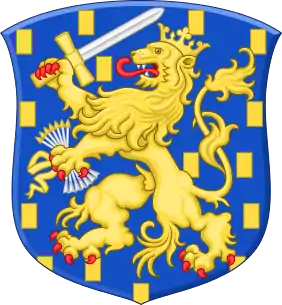House of Representatives (Netherlands)
The House of Representatives (Dutch: Tweede Kamer der Staten-Generaal, pronounced [ˈtʋeːdə ˈkaːmər dɛr ˈstaːtə(n) ˌɣeːnəˈraːl] (![]() listen); commonly referred to as the Tweede Kamer, literally Second Chamber of the States General) is the lower house of the bicameral parliament of the Netherlands, the States General, the other one being the Senate. It has 150 seats, which are filled through elections using a party-list proportional representation. It sits in the Binnenhof in The Hague.
listen); commonly referred to as the Tweede Kamer, literally Second Chamber of the States General) is the lower house of the bicameral parliament of the Netherlands, the States General, the other one being the Senate. It has 150 seats, which are filled through elections using a party-list proportional representation. It sits in the Binnenhof in The Hague.
House of Representatives Tweede Kamer der Staten-Generaal | |
|---|---|
| States General of the Netherlands | |
 | |
| Type | |
| Type | |
| Leadership | |
First Deputy Speaker | |
| Structure | |
| Seats | 150 |
 | |
Political groups | Government (demissionary)(75)[1]
Opposition parties (75)
|
| Elections | |
| Party-list proportional representation D'Hondt method | |
Last election | 15 March 2017 |
Next election | 17 March 2021 |
| Meeting place | |
 | |
| Binnenhof The Hague, Netherlands | |
| Website | |
| House of Representatives | |
Name
Although this body is officially called the "House of Representatives" in English, this is not a direct translation of its official Dutch name, the "Second Chamber of the States General", "Second Chamber" or more colloquially just the "Chamber". Rather than "representatives" (afgevaardigden), members of the House are referred to as Tweede Kamerlid ("member of the Second Chamber").
Functions
The House of Representatives is the main legislative body of the States General, where discussion of proposed legislation and review of the actions of the cabinet takes place. Both the Cabinet and the House of Representatives itself have the right to propose legislation; the House of Representatives discusses it and, if adopted by a majority, sends it on to the Senate. Review of the actions of the cabinet takes the form of formal interrogations, which may result in motions urging the cabinet to take, or refrain from, certain actions. No individual may be a member of both parliament and cabinet, except in a caretaker cabinet that has not yet been succeeded when a new House is sworn in.
The House of Representatives is also responsible for the first round of selection for judges to the Supreme Court of the Netherlands. It submits a list of three names for every vacant position to the Government. Furthermore, it elects the Dutch Ombudsman and their subsidiaries.
Elections
The normal term of the House of Representatives is four years. Elections are called when the government loses parliament's confidence, the governing coalition breaks down, the term of the House of Representatives expires or when no governing coalition can be formed.
Parties
Anybody eligible to vote in the Netherlands also has the right to establish a political party and contest elections for the House of Representatives. Parties wanting to take part must register 43 days before the elections, supplying a nationwide list of at most 50 candidates (80 if the party already has more than 15 seats). Parties that do not have any sitting candidates in the House of Representatives must also pay a deposit (11,250 euro for the November 2006 elections, for all districts together) and provide 30 signatures of support from residents of each of the 20 electoral districts in which they want to collect votes.
Party lists
The candidate lists are placed in the hands of the voters at least 14 days before the election. Each candidate list is numbered, with the person in the first position known as the lijsttrekker ("list puller"). The lijsttrekker is usually appointed by the party to lead its election campaign, and is almost always the party's political leader and candidate for Prime Minister. Parties may choose to compete with different candidate lists in each of the 20 electoral districts, but as seats are allocated on national rather than district level, most parties have almost identical lists in all districts with candidates running nationwide. Only large parties usually have some regional candidates at the bottom of their lists. From 1973 until abolition in June 2017 it was possible for two or more parties to combine their separate lists to increase the chance of winning a remainder seat. This was known as a 'list combination' or Lijstverbinding / lijstencombinatie.[2]
Registration and voting
Citizens of the Kingdom of the Netherlands aged 18 or over have the right to vote, with the exception of 1) prisoners serving a term of more than one year 2) those who have been declared incapable by court because of insanity 3) residents of Aruba, Curaçao and Sint Maarten, unless they have spent ten years residing in the Netherlands or work for the Dutch civil service.[3] Eligible citizens resident in the Netherlands are able to vote if they are registered on a municipal population register (Basisregistratie Personen). Eligible citizens outside the Netherlands can permanently register to vote at the municipality of The Hague, provided they have a current Dutch passport or identity card.
A single vote can be placed on any one candidate. Many voters select one of the lijsttrekkers (Jan Peter Balkenende, for example, received 2,198,114 of the CDA's 2,608,573 votes in the November 2006 elections), but alternatively a preference vote may be made for a candidate lower down the list.
Allocation of seats

Once the election results are known, the seats are allocated to the parties. The number of valid national votes cast is divided by 150, the number of seats available, to give a threshold for each seat (the kiesdeler); 1/150th is approximately 0.67% of the valid votes. Each party's number of votes is divided by this threshold, and rounded down to the nearest whole number, to give an initial number of seats equal to the number of times the threshold was reached.[4] Any party that received fewer votes than the threshold fails to gain representation in the House of Representatives. After the initial seats are allocated, the remainder seats are allocated among the parties that received at least one seat, using the D'Hondt method of largest averages. This system slightly favours the larger parties. Since parties that received fewer votes than required to obtain one whole seat are not eligible for remainder seats, there is a de facto election threshold of 0.67%.[5] This threshold is one of the lowest for national parliaments in the world, and there are usually multiple parties winning seats with 2% or less of the vote. Any party that did not have seats in the House at the time of the election will have its deposit refunded if it receives more than 75% of the threshold (1/200th of the vote).
Once the number of seats allocated to each party is known, in general they are allocated to candidates in the order that they appear on the party's list. (Hence, before the elections, the candidates near the top may be described as in an electable position, depending on the number of seats that the party is likely to obtain.) At this stage, however, the preference votes are also taken into account. Any candidate receiving more than one quarter of the threshold on personal preference votes (the 'preference threshold' or voorkeursdrempel, 0.1675% of the total number of valid votes), is considered elected in their own right, leapfrogging candidates higher on the list. In the November 2006 elections, only one candidate received a seat exclusively through preference votes, while 26 other candidates reaching the preference threshold were already elected based on their position on the list. If a candidate cannot take up the position in parliament (e.g., if they become a minister, decide not to enter parliament, or later resign) then the next candidate on the list takes their place.
Formation of governing coalition
After all seats are allocated, a series of negotiations take place in order to form a government that, usually, commands a majority in the chamber. Since 2012, the House of Representatives appoints a "scout" to ask the major party leaders about prospective coalitions. On the basis of the scout's interviews, the House of Representatives then appoints an informateur, who checks out possible coalitions, and formateur, who leads negotiations (in previous years the informateur and formateur were appointed by the monarch). It typically takes a few months before the formateur is ready to accept a royal invitation to form a government and become prime minister. All cabinet members must resign from parliament, as the constitution does not allow a cabinet member to hold a seat in the House of Representatives.
Due to the nationwide party-list system and the low election threshold, a typical House of Representatives has ten or more factions represented. Such fragmentation makes it nearly impossible for one party to win the 76 seats needed for a majority in the House of Representatives. Indeed, since the current party-list proportional representation system was introduced in 1918, no party has even approached the number of seats that are even theoretically needed to govern alone, let alone win enough for an outright majority. The highest proportion of seats won by a single party since then has been 54 out of 150, obtained by the CDA in 1986 and 1989. Between 1891 and 1897, the Liberal Union was the last party to have an absolute majority of seats in the House of Representatives. All Dutch cabinets since then have been coalitions of two or more parties.
House of Representatives offices
The buildings that house the individual offices of the Members of the House of Representatives and conference rooms for closed-door party meetings are all located on the Binnenhof. The main buildings of the old Ministry of Justice and Ministry of Colonial Affairs are used as accommodations.
 The old Ministry of Justice building
The old Ministry of Justice building The old Ministry of Colonial Affairs building
The old Ministry of Colonial Affairs building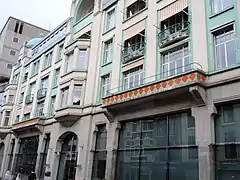 Grand Hotel Central building
Grand Hotel Central building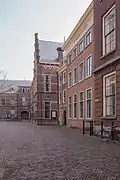 Binnenhof Building C
Binnenhof Building C Binnenhof Building 1A
Binnenhof Building 1A
|
|
|
|
|
Composition
Historical compositions
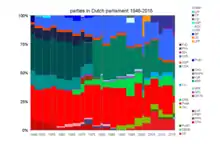
Until 1956, there were 100 seats. This was expanded to 150 seats, which is the current number.
To give an overview of the history of the House of Representatives, the figure on the right shows the seat distribution in the House from the first general elections after World War II (1946) to the current situation. The left-wing parties are towards the bottom, the Christian parties in the centre, with the right-wing parties towards the top. Occasionally, single-issue (or narrow-focus) parties have arisen, and these are shown at the extreme top. Vertical lines indicate general elections. Although these are generally held every four years, the resulting coalition governments do not always finish their term without a government crisis, which is often followed by fresh elections. Hence the frequent periods shorter than four years.
Current situation
The general election of 2017 was held on Wednesday, 15 March 2017, and followed the call for new elections after the Second Rutte cabinet had completed its four-year term. The new Members of the House of Representatives were installed on 23 March 2017. Four parties were required to form a coalition with a simple majority (76 seats). Rutte's VVD, as well as the CDA, D66 and CU parties, later agreed to form a governing coalition with the required one-seat majority after the longest time since an election took place, 209 days, surpassing the previous record of 208 days set after the 1977 general election.
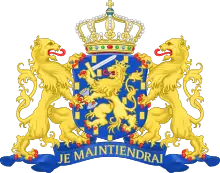 |
|---|
| This article is part of a series on the politics and government of Netherlands |
 | ||||||||
| Party | Lijsttrekker | Votes | % | +/− | Seats | +/− | ||
|---|---|---|---|---|---|---|---|---|
| People's Party for Freedom and Democracy | VVD | Mark Rutte | 2,238,351 | 21.3 | −5.3 | 33 | −8 | |
| Party for Freedom | PVV | Geert Wilders | 1,372,941 | 13.1 | +3.0 | 20 | +5 | |
| Christian Democratic Appeal | CDA | Sybrand Buma | 1,301,796 | 12.4 | +3.9 | 19 | +6 | |
| Democrats 66 | D66 | Alexander Pechtold | 1,285,819 | 12.2 | +4.2 | 19 | +7 | |
| GroenLinks | GL | Jesse Klaver | 959,600 | 9.1 | +6.8 | 14 | +10 | |
| Socialist Party | SP | Emile Roemer | 955,633 | 9.1 | −0.6 | 14 | −1 | |
| Labour Party | PvdA | Lodewijk Asscher | 599,699 | 5.7 | −19.1 | 9 | −29 | |
| Christian Union | CU | Gert-Jan Segers | 356,271 | 3.4 | +0.3 | 5 | +0 | |
| Party for the Animals | PvdD | Marianne Thieme | 335,214 | 3.2 | +1.3 | 5 | +3 | |
| 50PLUS | 50+ | Henk Krol | 327,131 | 3.1 | +1.2 | 4 | +2 | |
| Reformed Political Party | SGP | Kees van der Staaij | 218,950 | 2.1 | +0.0 | 3 | +0 | |
| Denk | DENK | Tunahan Kuzu | 216,147 | 2.1 | New | 3 | +3 | |
| Forum for Democracy | FvD | Thierry Baudet | 187,162 | 1.8 | New | 2 | +2 | |
| VoorNederland | VNL | Jan Roos | 38,209 | 0.4 | New | 0 | – | |
| Pirate Party | PP | Ancilla van de Leest | 35,478 | 0.3 | +0.0 | 0 | – | |
| Artikel 1 | A1 | Sylvana Simons | 28,700 | 0.3 | New | 0 | – | |
| Nieuwe Wegen | NiWe | Jacques Monasch | 14,362 | 0.1 | New | 0 | – | |
| Entrepreneurs Party | OP | Hero Brinkman | 12,570 | 0.1 | New | 0 | – | |
| Lokaal in de Kamer | LidK | Jan Heijman | 6,858 | 0.1 | New | 0 | – | |
| Non-Voters | NS | Peter Plasman | 6,025 | 0.1 | New | 0 | – | |
| The Civil Movement | DBB | Ad Vlems | 5,221 | 0.1 | New | 0 | – | |
| GeenPeil | GP | Jan Dijkgraaf | 4,945 | 0.0 | New | 0 | – | |
| Jezus Leeft | JL | Florens van der Spek | 3,099 | 0.0 | New | 0 | – | |
| Free-Minded Party | VP | Norbert Klein | 2,938 | 0.0 | New | 0 | – | |
| Libertarian Party | LP | Robert Valentine | 1,492 | 0.0 | +0.0 | 0 | – | |
| Party for Human and Spirit / Basic Income Party / V-R | MenS-BIP | Tara-Joëlle Fonk | 726 | 0.0 | −0.2 | 0 | – | |
| StemNL | SNL | Mario van den Eijnde | 527 | 0.0 | New | 0 | – | |
| Free Democratic Party | VDP | Burhan Gökalp | 177 | 0.0 | New | 0 | – | |
| Total valid votes | 10,516,041 | 100 | 150 | |||||
| Blank votes | 15,876 | 0.15 | ||||||
| Invalid votes | 31,539 | 0.3 | ||||||
| Total | 10,563,456 | 100 | ||||||
| Registered voters & turnout | 12,893,466 | 81.9 | +7.3 | |||||
| Source: Kiesraad | ||||||||
Parliamentary leaders
| Portrait | Name | Party | Service as Parliamentary leader |
Service as a Member of the House of Representatives | |||||
|---|---|---|---|---|---|---|---|---|---|
.jpg.webp) |
Dr. Klaas Dijkhoff (born 1981) |
VVD | 25 October 2017 (3 years, 105 days) |
23 March 2017 (3 years, 321 days) 17 June 2010 – 20 March 2015 (4 years, 276 days) | |||||
.jpg.webp) |
Geert Wilders (born 1963) [Party Leader] |
PVV | 30 November 2006 (14 years, 69 days) |
26 July 2002 (18 years, 226 days) 25 August 1998 – 23 May 2002 (3 years, 271 days) | |||||
.jpg.webp) |
Pieter Heerma (born 1977) |
CDA | 21 May 2019 (1 year, 262 days) |
20 September 2012 (8 years, 140 days) | |||||
.jpg.webp) |
Rob Jetten (born 1987) |
D66 | 9 October 2018 (2 years, 121 days) |
23 March 2017 (3 years, 321 days) | |||||
 |
Jesse Klaver (born 1986) [Party Leader] |
GL | 12 May 2015 (5 years, 271 days) |
17 June 2010 (10 years, 235 days) | |||||
.jpg.webp) |
Lilian Marijnissen (born 1985) [Party Leader] |
SP | 13 December 2017 (3 years, 56 days) |
23 March 2017 (3 years, 321 days) | |||||
.jpg.webp) |
Lilianne Ploumen (born 1962) |
PvdA | 14 January 2021 (24 days) |
23 March 2017 (3 years, 321 days) | |||||
.jpg.webp) |
Gert-Jan Segers (born 1969) [Party Leader] |
CU | 10 November 2015 (5 years, 89 days) |
20 September 2012 (8 years, 140 days) | |||||
.jpg.webp) |
Esther Ouwehand (born 1976) [Party Leader] |
PvdD | 9 October 2019 (1 year, 121 days) 9 October 2018 – 31 January 2019 (114 days) 24 January 2012 – 14 May 2012 (111 days) |
18 October 2016 (4 years, 112 days) 30 November 2006 – 17 November 2015 (8 years, 352 days) | |||||
 |
Corrie van Brenk (born 1960) |
50+ | 3 May 2020 (280 days) |
23 March 2017 (3 years, 321 days) | |||||
 |
Kees van der Staaij (born 1968) [Party Leader] |
SGP | 9 June 2010 (10 years, 243 days) |
19 May 1998 (22 years, 264 days) | |||||
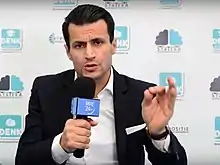 |
Farid Azarkan (born 1971) [Party Leader] |
DENK | 22 March 2020 (322 days) 23 April 2018 – 2 September 2018 (132 days) |
23 March 2017 (3 years, 321 days) | |||||
.jpg.webp) |
Dr. Thierry Baudet (born 1983) [Party Leader] |
FvD | 23 March 2017 (3 years, 321 days) |
23 March 2017 (3 years, 321 days) | |||||
| Independent Parliamentary leader |
Group/Member Former Party Seat(s) |
Service as Parliamentary leader |
Service as a Member of the House of Representatives | ||||||
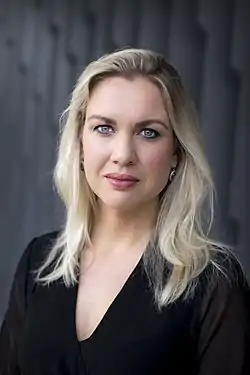 |
Femke Merel van Kooten (born 1983) |
Member Van Kooten (Left the PvdD) 1 |
6 August 2020 (185 days) 16 July 2019 – 3 May 2020 (292 days) |
4 February 2019 (2 years, 3 days) 23 March 2017 – 15 October 2018 (1 year, 206 days) | |||||
 |
Henk Krol (born 1950) |
Member Krol (Left 50+) 1 |
3 May 2020 (280 days) 10 September 2014 – 3 May 2020 (5 years, 236 days) 20 September 2012 – 4 October 2013 (1 year, 16 days) |
10 September 2014 (6 years, 150 days) 20 September 2012 – 4 October 2013 (1 year, 16 days) | |||||
| Wybren van Haga (born 1967) |
Member Van Haga (Expelled from the VVD) 1 |
24 September 2019 (1 year, 136 days) |
31 October 2017 (3 years, 99 days) | ||||||
- Also Party Leader
Members of the Presidium
| Portrait | Name | Position | Party | Service in the Presidium | Service as a member of the House of Representatives | |
|---|---|---|---|---|---|---|
.jpg.webp) |
Khadija Arib (born 1960) |
Speaker | PvdA | 13 January 2016 (5 years, 25 days) |
1 March 2007 (13 years, 343 days) 19 May 1998 – 30 November 2006 (8 years, 195 days) | |
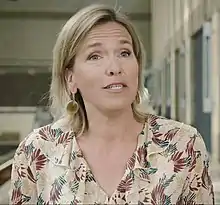 |
Ockje Tellegen (born 1974) |
First Deputy Speaker | VVD | 31 October 2017 (3 years, 99 days) |
20 September 2012 (8 years, 140 days) | |
.jpg.webp) |
Martin Bosma (born 1964) |
Second Deputy Speaker | PVV | 30 June 2010 (10 years, 314 days) |
30 November 2006 (14 years, 69 days) | |
_(cropped).jpg.webp) |
Dr. Madeleine van Toorenburg (born 1968) |
Third Deputy Speaker | CDA | 31 October 2017 (3 years, 99 days) |
1 March 2007 (13 years, 343 days) | |
.jpg.webp) |
Vera Bergkamp (born 1971) |
Fourth Deputy Speaker | D66 | 31 October 2017 (3 years, 99 days) |
20 September 2012 (8 years, 140 days) | |
| Tom van der Lee (born 1964) |
Fifth Deputy Speaker | GL | 14 June 2018 (2 years, 238 days) |
23 March 2017 (3 years, 321 days) | ||
 |
Dr. Ronald van Raak (born 1969) |
Sixth Deputy Speaker | SP | 23 June 2010 (10 years, 321 days) |
30 November 2006 (14 years, 69 days) | |
.jpg.webp) |
Joël Voordewind (born 1965) |
Seventh Deputy Speaker | CU | 20 September 2012 (8 years, 140 days) |
30 November 2006 (14 years, 69 days) | |
.jpg.webp) |
Henk Nijboer (born 1983) |
Eighth Deputy Speaker | PvdA | 5 June 2018 (2 years, 247 days) |
20 September 2012 (8 years, 140 days) | |
Parliamentary Committees
In the media
Plenary sessions of the house are broadcast via a live audio-only transmission called the Tweede Kamerlijn, available on the internet and through most Dutch cable operators. The service also broadcasts important committee meetings if there is no plenary at the time.
References
- "Netherlands: Coalition deal reached after 209 days". DW. Deutsche Welle. 9 October 2017. Retrieved 10 October 2017.
- Gijs Herderscheê (20 June 2017). "Fenomeen politieke lijstverbinding sneuvelt in Eerste Kamer". Volkskrant.
- Kiesgerechtigdheid, Government of the Netherlands, retrieved 2 December 2018
- "Kieswet, Hoofdstuk P". wetten.nl (in Dutch). 22 February 2019. Retrieved 7 July 2019.
- "Kiesdrempel, kiesdeler en voorkeurdrempel". Kiesraad.nl (in Dutch). 22 April 2016. Retrieved 7 July 2019.
- "Nieuwkomers Denk en Forum krijgen geen andere plek in zaal Tweede Kamer". NRC Handelsblad (in Dutch). 6 April 2017. Retrieved 4 November 2017.
- "Verhuizing Kamer lastige puzzel door eisen kleine partijen". Algemeen Dagblad (in Dutch). 7 April 2017. Retrieved 4 November 2017.
- "Reken niet zomaar op de SGP". NRC Handelsblad (in Dutch). 2 June 2017. Retrieved 4 November 2017.
- "Partijen onderhandelen over werkplek - wie eindigt op zolder?". NRC Handelsblad (in Dutch). 21 March 2017. Retrieved 4 November 2017.
External links
| Wikimedia Commons has media related to House of Representatives of the Netherlands (Tweede Kamer). |
- Official website
- (in Dutch) Official site
- Virtual tour of the houses of parliament
- (in Dutch) Seat allocation in the House of Representatives. Click the diagram on the left to see names and photos of all representatives per section.
- (in Dutch) Official site for archives since 1995
